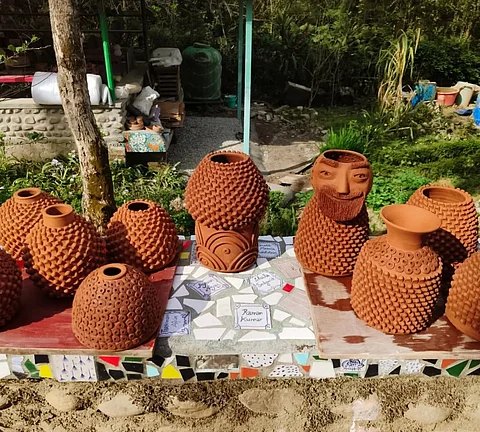
- Destinations
- Experiences
- Stay
- What's new
- Celebrating People
- Responsible Tourism
- CampaignsCampaigns
- Subscribe
- Buy Now

Nestled in the picturesque Kangra Valley and surrounded by the majestic Dhauladhar mountains, Andretta village looks like it came straight out of a postcard. Surrounded by the majestic Shivalik Hills on one side and the stunning Dhauladhar range on the other, this charming village has earned its reputation as an arts village, celebrated for its vibrant artistic community and rich cultural heritage.
Founded in the 1920s by the Irish theatre actress and playwright Norah Richards, the arts village has since flourished as a sanctuary for creative expression. Andretta is not only a haven for artists but also a historical site that reflects the artistic movements leading up to India's independence. Over the decades, it has nurtured many renowned artists, craftspeople, and performers, forging a unique blend of tradition and modernity. The village boasts various art galleries, workshops, and cultural events that continue to attract artists, art lovers, and tourists keen to explore its artistic legacy.
Richards was an environmentalist who founded the serene village of Andretta in Himachal Pradesh, seeking solace and inspiration amid its lush landscapes and tranquil surroundings. Her dedication to nature and the arts soon sparked a remarkable transformation within the community. Under her guidance, Andretta blossomed into a vibrant hub for artists, playwrights, and potters, drawing creative minds from far and wide. The once quiet village became a melting pot of creativity in these hills, where the beauty of the environment inspired an array of artistic expressions, from captivating plays performed under the stars to intricate pottery reflecting the essence of the natural world.
In the 1930s, Richards chose to make a small village in the Kangra Valley her home, a place that was completely unknown to the outside world at the time. Reaching Andretta required an arduous journey, which included a 12-hour train ride, followed by a bus ride, and then several miles on foot or horseback. In this village, Richards constructed a traditional Kangra house using mud and wood, and even set up a makeshift stage.
She began inviting local theatre artists and amateurs to perform, gradually laying the groundwork for what would become the Punjab Theatre Movement between the 1940s and 1960s. Norah's passion attracted many artists to Andretta, including B.C. Sanyal, who painted backdrops for several plays, and Sardar Sobha Singh, the renowned portrait painter. Over time, the little village transformed into a vibrant retreat for artists of all kinds, and locals began referring to it as "Mem da pind." Even the young Prithviraj Kapoor worked under Norah during his early theatre days. It's easy to see why Norah selected Andretta as her home.
The heart of Andretta's cultural scene lies in the Andretta Pottery and Craft Society, which was founded by Mansimran "Mini" Singh, the son of renowned potter Gurcharan Singh of Delhi Blue Pottery. The society offers a variety of experiences for visitors, including the option to enroll in longer pottery courses that come with accommodation and meals. Here, you can observe the pottery-making process, purchase handcrafted earthenware, try your hand at creating pottery, and explore the Terracotta Museum, which showcases a collection of pottery and terracotta art from Himachal Pradesh and other regions.
The Andretta Artists' Village is home to several art galleries and studios, where visitors can admire and purchase local artworks. The most prominent are the Sobha Singh Art Gallery, which showcases the work of artist Sobha Singh, and the Andretta Pottery and Craft Society. A significant attraction in Andretta is Norah Richards' house, which has been preserved as a heritage site. This house offers a glimpse into the life and work of Richards and stands as a testament to her contributions to Indian theater and the arts. While not a gallery in the traditional sense, Norah Richards' mud house is a preserved heritage site and a significant part of the village's artistic history.
The Andretta Artists Cooperative is a vibrant community of artists and craftspeople which fosters a space for creative exchange and innovation, hosting exhibitions and workshops. The cooperative showcases a range of art forms, including pottery, painting, printmaking, and more. Besides Norah Richards, notable figures like Sardar Gurcharan Singh (potter) and Sobha Singh (painter) have been integral to the colony's development.
Andretta is a 13 km drive away from Palampur. The nearest airport to Andretta is Gaggal Airport (Dharamshala), located approximately 40 km away. The closest major railway station is Pathankot, situated about 85 km from Andretta. There's also a smaller railway station called Panchrukhi, but Pathankot is generally preferred for better connectivity.
The ideal time to visit Andretta is in spring (March to June) and autumn (September to November) when the weather is clear and pleasant.
In Andretta, there are several accommodation options for all budgets, including hotels, resorts, and homestays, many of which are located near the pottery and craft society. Popular choices include The Mirage Andretta and The Kut House Homestay. The Mirage Andretta is a charming and comfortable hotel featuring a cottage, a mud house, and a white house. Additionally, The Lodge at Wah in Palampur is a highly-rated option, especially for families visiting Andretta.
The charming village and its surrounding areas have several popular places to eat. The Imperial Dining Hall is known for its Chinese and Indian cuisine. The Off-road Cafe & Pizzeria specialises in contemporary and Italian dishes. You can head to Cloud - 7 which offers Mexican and Indian food, as well as a bar. Or try The Blue Hills Cafe which features great fast food options and beverages.
